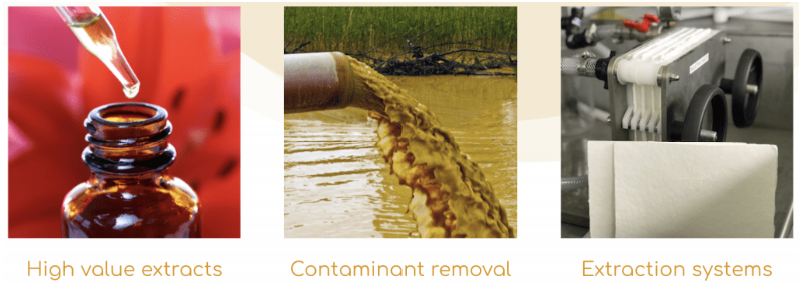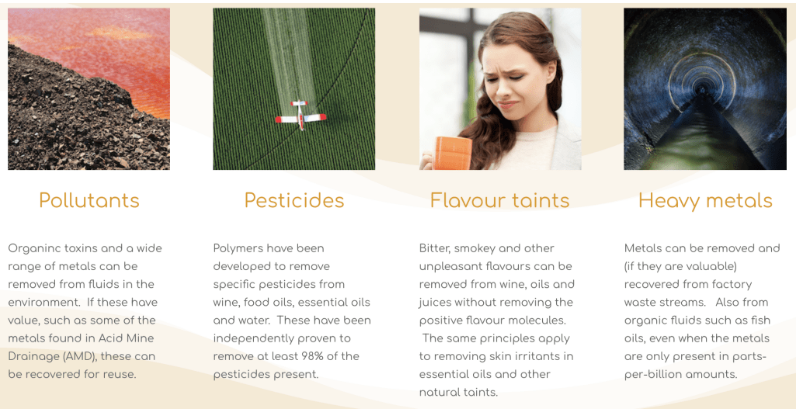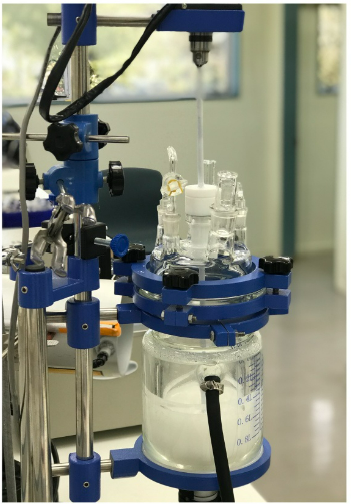What’s a polymer? According to the American Chemistry Council a polymer is a “useful chemical made of many repeating patterns.” And unless you’re a polymer scientist yourself or are otherwise well versed in what that actually implies, the word polymer is one we’ve likely all heard but don’t really understand.
Molecularly Imprinted Polymers, on a basic level, are materials used to bind specific molecules. They’re somewhat like an artificial antibody and are normally used for small scale sample clean up or detection purposes in analytical chemistry labs.
Ligar, however, is taking a very different approach. Their R&D and manufacturing facility in Hamilton, New Zealand conducts polymer research that is cutting edge and downright fascinating.
 Polymers can be used for all three of these activities.
Polymers can be used for all three of these activities.Rather than working on a small scale with small volumes, Ligar set out to develop and manufacture polymers that can be used and reused thousands of times to extract specific molecules from very large volumes of liquids. This is no easy task. Sometimes molecules in liquids are harmful or foul-tasting and need to be removed. Other times, molecules can be used for positive gain elsewhere so need to be isolated and collected.
Over the past eight years the Ligar team has made some incredible developments and discoveries. On the negative molecule side, they have developed polymers that remove taints from wine. These range from pesticides to yeasts to unwanted smoky undertones that get into wine as a result of nearby bushfires. These molecules can be problematic at very low levels, sometimes less than 10 parts per billion, but Ligar’s polymers are able to selectively target and remove the unwanted molecules.
Another polymer Ligar has developed removes chromium from tannery waste water in a way where it can be reclaimed and reused. Without the use of this polymer, harmful chromium waste ends up in landfills and rivers which negatively impacts human and environmental health. This comprehensive solution protects communities and enables tanneries to reduce overhead costs. Everybody wins.
On the positive molecule side, the Ligar team has developed polymers which rapidly capture cannabinoids, the medicinal molecules in cannabis. The process they have developed can be used for very large volumes of extract, cuts out laborious steps in the standard cannabis purification process and results in a better quality product. Ligar also developed polymers for isolating specific super-sweet zero calorie sugars from monk fruit juice.
 Other instances where Ligar’s polymers have been used to extract molecules
Other instances where Ligar’s polymers have been used to extract moleculesAlongside polymer development, Ligar has scaled manufacturing from milligrams to tons and their polymers are certified as food safe under European Food Safety Authority and FDA regulations. Ligar’s work is certainly wide-ranging, captivating and important.
So how’d they get this done? A lot of research, documentation and using best practices to protect their high level, high value research and intellectual property.
A year ago, LabArchives consultant Olivia Sisson met with Ligar to work out how they could best use the LabArchives platform to improve efficiency in their labs and protect their intellectual property.
 Documenting exactly how polymers were developed is crucial when it comes to scaling up production and application.
Documenting exactly how polymers were developed is crucial when it comes to scaling up production and application.Ligar revamped their lab book structure and created a notebook dedicated to each project. All experiments are entered here and allow anyone in the lab to quickly find any and all work linked to whatever polymer they’re interested in. “It’s so easy to go back and find what you need,” said Rebecca Ericksen, “trying to do this when we were using paper and digital was a nightmare. Now we can even find things quickly that were done several years ago.”
The team at Ligar are building a repository for themselves. A few people have come and gone from the lab but their digital documentation is still on hand. None of the important data that supports Ligar’s sensitive research is ever at risk of getting lost.
Ligar has built four different types of polymers that all have large scientific and economic potential. Now they’re developing the infrastructure to deliver these polymers to the world. In the meantime, they need to ensure that their research and hard work is protected from theft. In the modern age, intellectual property theft is a very real and very costly possibility. And when a lab is doing work as high level as Ligar’s, they can’t afford mistakes. Even small labs like Ligar, need to protect their work and document how they developed their solutions and products.
These two items 1) keeping track of research evolution and 2) protecting findings from theft are massively important as Ligar works to scale their polymers up for use on the industrial scale. For now they can rest easy knowing they’ve got both of these items covered in LabArchives.

















